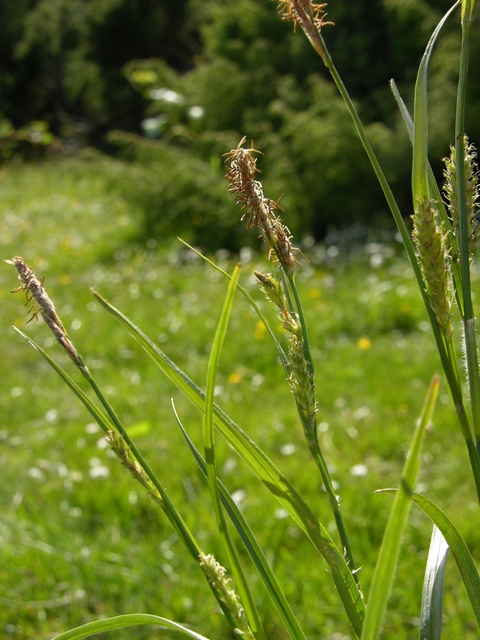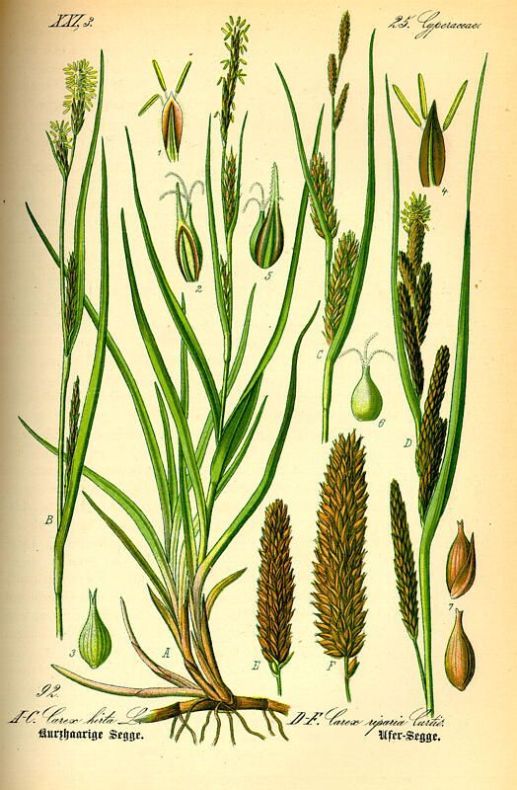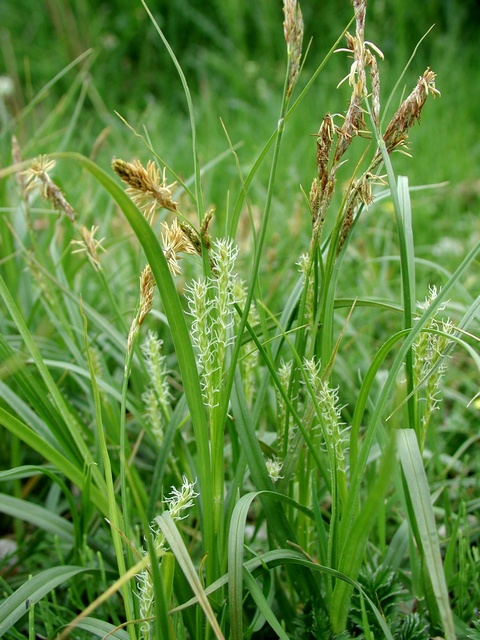Carex hirta
Female spikes of hairy sedge ( Carex hirta )
The Hairy Sedge ( Carex hirta ), also known as Rough sedge, a plant belonging to the family of sour grass plants is ( Cyperaceae ). It is one of the most common sedges and is one of the few clearly hairy sedge species.
Features
The Hairy Sedge is a perennial, herbaceous plant that reaches the heights of growth between about five to 60 centimeters. It is a deciduous Geophyt, the long forms underground runners in the growing season. The shoots are erect, obtuse triangular and leafy to the top. On rung reason it has some spreitenlose, brown to purple colored, while tearing weak netzfaserige leaf sheaths. The flat, slightly rinnigen green to gray- green leaves are scattered to woolly hairy, rarely also completely bald and about three to six millimeters wide. The edges of the gradually narrowing to the tip of leaf blades are rough. The ligule ( ligule ) is flachbogig.
The bracts of the inflorescence leaf-like foliage and are usually longer than this. The inflorescence consists of three to nine sitting to long-stemmed, upright ears. The Hairy Sedge is a Mixed -spiked sedge. It has two to six ovoid to short cylindrical female and about one to three slender cylindrical male ears. The multifloral female ears are one to three inches long and about seven millimeters wide. You step out of their bract and are usually not distributed to all stems. The male ears protrude beyond the female and are up to three millimeters long and only four millimeters wide. The brown, green keeled, about four to eight millimeters long husks narrowing into a spike tip. Male and female flowers with three stamens ( anthers ) and dreinabigen ovary. The yellow- green colored fruit hoses are available from an angle and are five to seven millimeters long and two millimeters wide. They narrowing into a long, deep bidentate beak. The yellow-brown fruit is obovate and triangular. They are hairy slightly inflated and often scattered to dense. The Hairy Sedge flowers from April to July.
In most cases the whole plant is hairy, often the hair is limited to individual sites, particularly at the vicinity of the mouth of the leaf sheaths. Some authors, this form is called the Carex hirta variety hirtiformis var construed.
Distribution and location
The Hairy Sedge comes across Europe before with the exception of the far north, North Africa and Asia Minor. In North America and New Zealand it has been introduced ( neophyte ). It grows on rich, moist to wet-dry, often premolars meadows and pastures, along roadsides and embankments in ruderal or forest edges.
Socialization
The Hairy Sedge is by Oberdorfer a Kennart the order of the flood and wetland pioneer grass ( Agrostietalia stolonifera ) and of impact plant communities ( Plantaginetalia majoris ). It also grows in halbruderalen couch grass dry warm sites in arid and semi- arid grassland and nutrient-rich herbaceous and perennial weeds corridors.
Ecology
Ecological indicator values according to Ellenberg: L - 7 T - 6 K - 3 F - 6 ~ R - XN - 5 S - 0
The plant is a half-light plant, which means it grows in full light, but bear in borders shading. It thrives best on moist to wet soils, but tolerates very strongly varying moisture conditions at their location. Your ecological focus is on moderately nitrogen- supplied soils on nitrogen-poor and - rich sites is rare. It is not ertragend salt and a little warmth. As a deep-rooting and Wurzelkriechpionier the Hairy Sedge contributes significantly to soil consolidation.
The flowers of hairy sedge are wind pollinated ( anemophily ). The seeds are spread either by the wind ( Anemochorie ), by water ( Hydrochorie ), through self- propagation ( Autochorie ) or by the adhesive effect of the seeds ( Epichorie ), which can stick to animals.
Threats and conservation
The Hairy sedge is known worldwide as not endangered and does not enjoy any special legal protection.
Detail Photos
Drive
Offshoot
Male spikes









